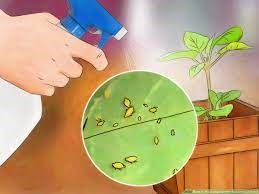Only Use DIY Neem Oil ‘Indoors’ Without Harming Bees
Recent research questions common wisdom that neem oil is harmless to bees.
By
Neem oil is a vegetable oil from the seeds and fruit of the neem tree Azadirachta indica, native to India, Southeast Asia, and some parts of Africa. It has long been used in traditional Ayurvedic medicine as a skin and hair treatment but is also increasingly used today as an insecticide.
You can find dozens of websites touting its benefits, and indeed, it is an effective and organic insecticide. Neem oil can kill insects directly, but its main ingredient interferes with insects’ normal life cycle because it is similar to insect hormones, so it acts as a deterrent to growth and reproduction. Neem oil is also a fungicide and can improve the quality of soil for agricultural uses.
Neem Oil Is Organic, But Is It Safe?
Most recommendations of neem oil found online consider it to be generally environmentally friendly and harmless. Some scientific research backs this up, such as a finding that neem oil applications “pose little risk of harm to decomposer invertebrates” like earthworms. But scientific evidence is usually lacking among the recommendations online, and a recent review of the scientific literature warns that “little is known about the non-target toxicity of neem-based insecticides.”
While much of the research that exists reports no adverse environmental effects, specific studies suggest that over-spraying of neem oil can lead to runoff and accumulation in waterways, resulting in adverse effects on aquatic organisms, including plankton and fish, and on birds such as quail.
Studies of the effect of neem oil on bees have made neem oil controversial for outdoor use, including the recommendation by one leading study that its use “should be avoided in crops during the flowering stage when the plants are visited by bees.” Recent research shows evidence of an anti-feeding effect in some bee species, and reduced reproduction rates and increased queen bee mortality in others. Results do vary depending on the concentration level of neem oil in the insecticidal solution, but as one study warns, “[a]ll of these factors could potentially compromise colony survival.”
Neem oil is usually applied in two ways. As a foliar spray, it can cause pests to suffocate, bees included. As a systemic insecticide, plants’ roots take up the oil into their tissues, and when pests ingest plant tissue, the active ingredient of neem oil, azadirachtin, interferes with their normal reproductive life cycle. This same effect happens when bees ingest pollen and bring it home to their hives, disrupting the colony or even killing the queen.
As a result, given the worldwide threat of colony collapse disorder and the important role that bees play in the production of food, this article recommends using neem oil only on indoor plants. For outdoor use, there are alternatives.
Alternatives to Neem Oil for Outdoor Use
There are pollinator-friendly alternatives to neem oil outdoors, such as olive oil mixed with organic Castille soap to suffocate pests such as rose slugs or aphids; Bt, a bacterial toxin, to kill caterpillars; or products containing the active ingredient Bacillus subtilis, to control fungi like black spot and powdery mildew. It’s always best to apply any insecticide at dawn or dusk, before or after bees and other pollinators are feeding. If you see bees, put the sprayer away.
How To Use DIY Neem Oil Without Harming Bees (treehugger.com)









